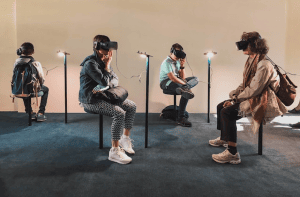Samantha Foss is a tech-sector entrepreneur who contributes to online publications on industry related news. In the following article, Samantha Foss discusses what is to be gained, and what may be lost, through the introduction of AI in schools.
With the rise of technological advancements in AI, it seems as though more and more schools are welcoming its use in their classrooms. However, for some, it seems as though the use of this tech may bring about more harm than good.
This is mainly part to the fact that AI hasn’t been about long enough for the world to see just how beneficial it may be to the education sector.
The Positives of AI Introduction
· Immersive Learning
Samantha Foss says that there is much to be said about the level of immersionthat comes along with AI tech in schools. AI allows students of all ages, but especially those in higher education, to be able to interact with their world in a way once inconceivable. This could change the course of learning indefinitely.
This could mean virtual field trips for elementary-aged children, and it could mean extremely detailed instruction for college-age students studying design, engineering, patient care, architecture, and the like. For the latter, it will allow them to interact with reality in a way they can’t in the real world.
· An Education That Mimics Reality
Samantha Foss says that something that cannot be argued by either side is that technology is a social norm. There is no escaping tech, whether it be something as granular as a smartphone, to the use of smart devices in our homes. It’s likely that most students are using technology of this caliber outside of the classroom, so it makes sense that some want this in schools as well.
Samantha Foss explains that introducing AI technology to our classrooms means that institutions are keeping up with the ever-changing world. A number of children have already been introduced to AI through Oculus headsets, though they’re still in their maiden years, it won’t be long until AI becomes a household reality.
· Real-World Problem Solving
One of the biggest arguments for supporters of AI in schools involves real-world problem-solving. The use of AI allows each student to be catered to by their own “personal teacher” through the form of artificial intelligence.
Samantha Foss explains that this allows students to solve problems at a whim, in the same way, they would through an instructor, though this time without the teacher needing to look after an entire classroom of students at once. Since AI learns through constant interaction, students will be able to accelerate in tune with their teacher, allowing for a customized learning experience.

The Potential Downfalls of AI Introduction
· Cost
Of course, one of the biggest concerns for AI introduction is the potential cost of this technology. For most, there seems to be an understanding that funds should be allocated for higher education and college students who can responsibly handle the equipment, rather than younger students who may not grasp the cost of the machinery.
Samantha Foss says that there are also those wondering how accessible this kind of technology may be to institutions in lower-income environments. Budget for this kind of this introduction across schools can be difficult to predict and fulfill, so many are calling for there to be equal opportunity for institutions across the board.
· Technology Addiction
Samantha Foss explains that many are worried about what the introduction of such immersive technology could mean for young minds. There’s a great concern about technology addiction, especially for those in elementary and middle school, between the use of TV, iPads, phones, and now AR technology.
Because of the endless capability an AI has over a teacher (including personalized learning, unparalleled attention to a single student, etc.), many are concerned that students and teachers will become reliant on technology over traditional learning, dismantling the student-teacher relationship.
Samantha Foss also reports that there are calls to have institutions balance AI technology with face-to-face learning in order for there to be a lessened risk of technology addiction.
· Lack of Interpersonal Relationships
Though helpful, learning through AI software– even if it involves interacting with peers takes away an important layer of learning that is deemed necessary: personal closeness. There is a relationship formed through face-to-face learning that isn’t fulfilled through AI immersion.
There was a former study done that drove home the idea that there needs to be a balance found with AI instruction and traditional teaching to promote appropriate social adaptability and to fight feelings of loneliness and the like.